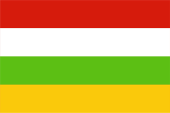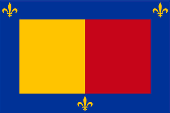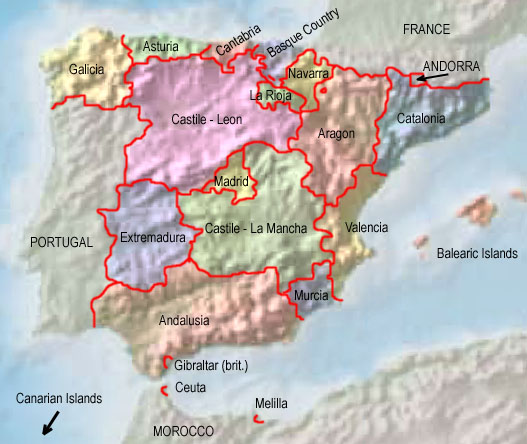mobile View, to the German Version tap the flag


- Autonomous Region of Spain
- former Province of Logroño
• Flags
• Historical and other Flags
• Meaning/Origin of the Flag
• Coat of Arms
• Meaning/Origin of the Coat of Arms
• Map of the autonomous regions of Spain
• Numbers and Facts
• History
• Origin of the Country's Name

since 1982,
official flag of La Rioja,
ratio = 2:3,
Source, by: Flags of the World






since 1982,
flag with the colours of La Rioja,
ratio = 2:3,
Source, by: Wikipedia (ES), World Statesmen





to 1982, Prov. Logroño,
unofficial flag of the Provincial Council,
ratio = 2:3,
Source, by: Wikipedia (ES)




1978–1982,
unofficial flag of La Rioja,
ratio = 2:3,
Source, by: Wikipedia (ES)




The current flag of La Rioja was presented - without coat of arms - for the first time in public in 1978, at the "1st Day of La Rioja" in Nájera. It was created by several students around the heraldist José María Ignacio Oria de Rueda y García-Manso and very quickly gained recognition and spread. It shows four horizontal stripes in red, white, green and yellow.
The colors of the flag come from the coat of arms of the province of Logroño, introduced in 1957, and represent:
• Red: wine, vineyards
• White: brightness, rivers, sky
• Green: fields, orchards, mountains, forests
• Yellow: lands, monuments but also fertility
The colors of the flag are fixed by law, they should be: Red = Pantone 485, Green = Pantone 368, Yellow = Pantone 123. The province of Logroño (in 1980 renamed in La Rioja) officially adopted the flag on 14th of August in 1979. With the Statute of Autonomy, signed on 9th of June in 1982, the flag was adopted for the now renamed La Rioja.
Under the government of General Franco (1936–1975), all regional flags were banned. The flag of the Provincial Council of Logroño was also never officially adopted. After Franco's death (1975), the regional flags were reintroduced, or new ones were created.
In most of the autonomous regions of Spain, the more recent flag history began in the years before the granting of the Statute of Autonomy with a flag without arms, because often the arms had not yet been decided. After all, it has mostly been accepted that the flag with the coat of arms is used by the regional authorities or on official occasions, and the flag without the coat of arms is to be used quasi for private, decorative purposes.
Source: Wikipedia (ES),
Flags of the World,
Volker Preuß


since 1982,
Coat of arms of La Rioja,
Source, by: Wikipedia (ES)

The coat of arms was created in 1957 for the province of Logroño. With the Statute of Autonomy, signed on 9th of June in 1982, the coat of arms of the province of Logroño was adopted for the now renamed La Rioja, with marginal modifications. Article 6 and 7 of Law 4/1985, of 31st of May, confirms the coat of arms and describes it in more detail. The escutcheon is split per pas with a surrounding blue border with three golden fleurs-de-lis. It shows in its heraldic right half on a golden background a red cross of Santiago, on the left and on the right each a white pilgrim's shell (scallop shell), in the lower part a green mountain. The heraldic left half shows on a red background a golden castle with three towers above a golden bridge. Below appears a river, indicated by white and blue wavy lines. The cross of Santiago recalls the Battle of Clavijo, the scallop shell the Way of Saint James that runs through the country, the green mountain is Monte Laturce, the highest mountain of La Rioja. The castle and the bridge are included in the coats of arms of most of the towns of La Rioja, in order to have a unifying effect. The castle also reminds us of the fact that those towns were once under the Crown of Castile. The river is the Ebro, which is very important for the country. The lilies were once awarded to the city of Logroño in recognition of "noble deeds" by Castilian monarchs and were last confirmed by Charles V. in the 16th century. The crown recalls that the provincial councils were created in the 19th century on royal initiative - by Queen Isabel II.
Source: Wikipedia (ES)

The autonomous Regions of Spain:

Source: Freeware, University of Texas Libraries, modyfied by: Volker Preuß

Area: 1.948 square miles
Inhabitants: 319.892 (2022), mostly castilized Basques
Density of Population: 164 inh./sq.mi.
Capital: Logroño, 150.020 inh. (2022)
official Language: Spanish (Castilian)
other Languages: Basque-tinted Spanish (Castilian)
Currency: Spanish (Euro) currency
Time Zone: GMT + 1 h
Source: Wikipedia (DE)

Today's La Rioja was originally a part of Castile. In 1833, the province of Logroño was created, from which the Autonomous Community of La Rioja emerged in June 1982. The inhabitants are mostly of Basque descent, but speak only a Basque-tinted Spanish. The country owes its autonomy precisely to this circumstance, the back-and-forth between Spanish-Castilian central power and Basque independence aspirations.
Source: Wikipedia (ES)

The origin of the country's name, first mentioned in the 11th century, is not clear. There are many theories. One of them says that the name "La Rioja" supposedly originated from the name "Rio Oja" (River Oja). The Oja is a very small river, four kilometers long, in the extreme north of La Rioja, which flows past the village of Casalarreina and joins the Rio Tiron at Cihuri. This flows after ten kilometers into the Rio Ebro. Why this "creek" of all things should have coined the name of the country is not to be explained.
Source: Wikipedia (ES)


![]()















